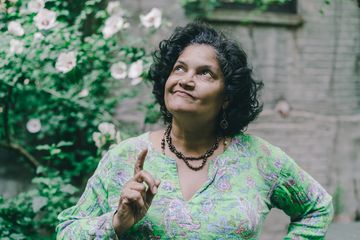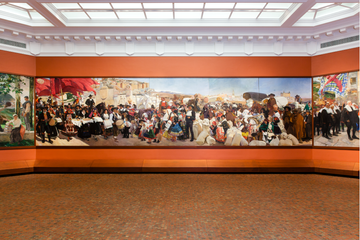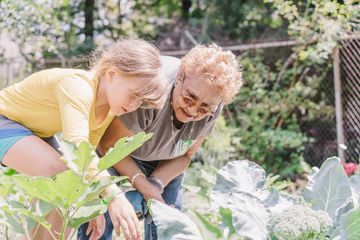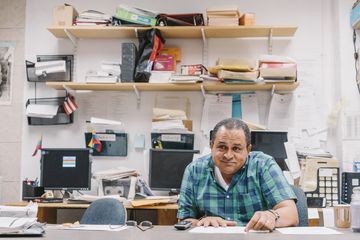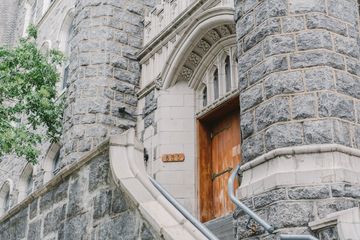"You're lucky to meet her today; she's famous in this area. " This is how I was greeted by two lovely women who were busy at work in the beautiful garden that I discovered on 138th and Riverside Drive. And they were absolutely correct. What an amazing lady Jenny Benitez turned out to be. At eighty-six years old, she was working the land as if she were still in her twenties. Her enthusiasm, her spirit and her belief in the flowers, trees and plants that she has been cultivating since 1980 has got to be an inspiration to anyone who has the pleasure of meeting her. When I asked Jenny if we could sit for a moment and have her share her story, she immediately settled down and began. Thirty-five years ago, in the early 1980s, this area was a "real mess. " The space where we were sitting had been filled with drugs and nothing but garbage, abandoned cars and debris. "It was real bad, " Jenny reflected. She was living on Riverside Drive, just opposite the park, and was raising four children. She needed a place for them to play and decided that she was going to take it upon herself to clean up this space. With her husband by her side every step of the way, until he passed away in 2016, they cleaned it up and have kept it going all these years. Today, the gardens and park area extend from 135th up until 143rd Street. On 138th, there are sixteen small plots that are community gardens within the gates of Jenny's Garden. People in the neighborhood pay a small fee and are allowed to plant whatever they would like, but they must maintain it and also lend a hand in taking care of the rest of the property. One of the volunteers I spoke to was proud to show me her patch of soil decorated with pinwheels and colorful trinkets, and the impressive cucumbers almost ready to be harvested. She also mentioned that the couple tending to the land adjacent to hers was vacationing for the summer, so she took it upon herself to plant tomatoes and eggplants in their soil for when they return. If Jenny feels that volunteers are not contributing their share of the work, she does not hesitate to ask them to leave. Jenny's true passion, however, are the endless vegetable patches that include broccoli, collard greens, eggplant, string beans, potatoes, Swiss chard and so much more. On our guided tour, Jenny proudly pointed out her fruit trees including pear, peach, apple, cherry, plum and even apricot. "This is all for the homeless, " she announced. "There is a church on Riverside Drive and 114th Street that I donate everything we grow. "As we continued to stroll through the pathways, we discovered a butterfly garden. Jenny stopped here and said that she always imagined this to be a fun spot for children to come and discover. There were butterflies fluttering about as well as numerous birds singing and flying to and from the different trees. And when we were there in the middle of the summer of 2017, the pink and blue hydrangea were in full bloom, the roses were getting ready to come out, and there were a variety of lilies, hibiscus and numerous other flowering plants making it not only look gorgeous, but also smell heavenly. What an oasis in the middle of our city, not only for children, but for adults as well. I was fascinated by what this woman had created in the middle of New York. I had so many questions. Where did she get the water, initially? "Oh, that was easy, " she declared. I ran a long hose from my apartment window, across the street and into the garden. Several years back, the Trust for Public Land provided a water source and then Jenny said that today, in 2017, they are busy building an irrigation system. "Green Thumb sent me two groups of students from Bronx Science and Stuyvesant High School. " Together, they have already built benches and greenhouses. She then added that Columbia University provided fences, at one point, to help her to protect the land. How did Jenny manage to remove the dozens of homeless people who were living in the park? "I just began cleaning the place up and I had conversations with each of them. " Slowly, she moved them out. "I was not displacing them, I was just taking care of nature, " she joyfully exclaimed. "By the time they were leaving, I had them all calling me Mama. " Jenny then went on to tell us that she had done this "practically on my own, " with the help of her husband, her own kids and the children in the neighborhood. "Honestly, I don't know how I did this. I went to sleep one day and woke up and this was here, " she said with a big smile. Jenny has been living at the same address on Riverside Drive for some fifty-five years and has had the extreme pleasure of watching the neighborhood change and change again. When I inquired about her relationship with the city, Jenny responded, "The city doesn't give me any problems. I give them problems. " She then continued, "I planted whatever I pleased then and to this day, I still do. " I then learned that Jenny was a school teacher, but retired in 2002. At that time, the River Park Conservancy offered her a small salary to keep going with her gardening project, and as she put it, "I am still on it, " and then added, "You cannot imagine how much I love it. I wish I could write, I have so much to tell - chapters and chapters to share - but God gives different energies to each of us. My gift is to communicate with the people and to bring magnificence to New York. "
